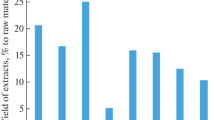The qualitative and quantitative compositions of several biologically active compounds (BACs) in various organs from plants of the family Plantaginaceae, including pharmacopoeial P. major, were studied. The compositions of extracted compounds were identical qualitatively but differed quantitatively depending on the plant species and organ. The plants were placed in the following order with respect to total content of BACs: P. uliginosa > P. major > P. salsa > P. cornuti > P. stepposa > P. lanceolata > P. media. The results indicated that these plants could be used as additional sources of BACs.


Similar content being viewed by others
References
P. Apexa and R. Saravanan, Electron. J. Plant Breed., 1, 6 (2010).
A. B. Shipunov, Candidate Dissertation in Biological Sciences, Lomonosov Moscow St. Univ., Moscow, 1998, 226 pp.
B. M. A. Razik, H. A. Hasan, and M. K. Murtadha, Iraqi Postgraduate Med. J., 11, 1 (2012).
M. Mazid, T. A. Khan, and F. Mohammad, Biol. Med., 3, No. 2, Spec. Issue, 232–249 (2011).
T. S. Morozkina and A. G. Moiseenok, Vitamins. Concise Handbook for Physicians and Students of Medical, Pharmaceutical, and Biological Specialities [in Russian], Asar, Minsk, 2002, 112 pp.
USSR State Pharmacopoeia, No. 2, General Analytical Methods, Medicinal Plant Raw Material [in Russian], Moscow, 1989, 400 pp.
N. K. Kochetkov, Chemistry of Biologically Active Compounds [in Russian], Khimiya, Moscow, 1970, 378 pp.
E. A. Krasnov, T. P. Berezovskaya, and N. V. Alekseyuk, Isolation and Analysis of Natural Biological Compounds [in Russian], Izd. Tomsk. Univ., Tomsk, 1987, 631 pp.
E. G. Bligh and W. J. Dyer, Can. J. Biochem. Physiol., 37, 8 (1959).
V. E. Vaskovsky and N. A. Latyshev, J. Chromatogr. A, 115, 1 (1975).
M. Kates, Techniques of Lipidology: Isolation, Analysis, and Identification of Lipids, Elsevier, New York, 1972, 342 pp.
Author information
Authors and Affiliations
Corresponding author
Additional information
Translated from Khimiya Prirodnykh Soedinenii, No. 6, November–December, 2014, pp. 869–872.
Rights and permissions
About this article
Cite this article
Bogdanova, E.S., Grebenkina, T.M., Nesterov, V.N. et al. Biologically Active Compounds from Representatives of the Family Plantaginaceae. Chem Nat Compd 50, 1001–1004 (2014). https://doi.org/10.1007/s10600-014-1146-y
Received:
Published:
Issue Date:
DOI: https://doi.org/10.1007/s10600-014-1146-y




